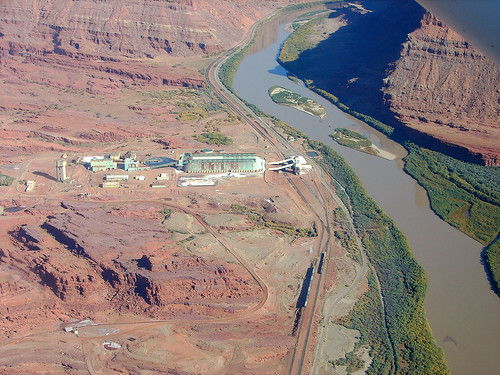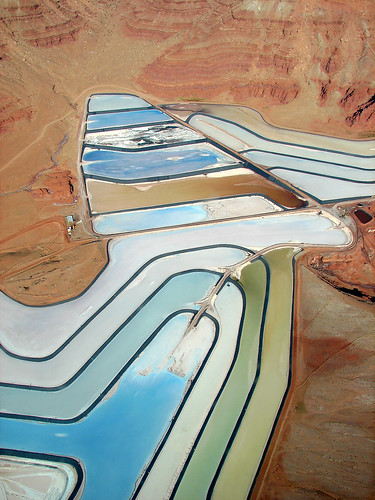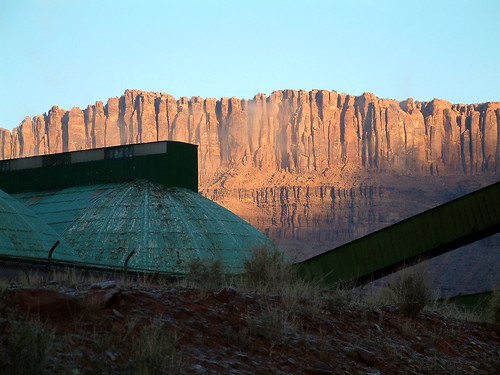Potash Potluck
Posted by Big Gav in fertiliser, phosphate, phosphorus, potash
The Australian reports today that BHP has bought a Canadian potash company.
MINING giant BHP Billiton said today it had agreed to buy Anglo Potash for $C284 million ($A300 million). BHP Billiton said Anglo Potash's only asset was its 25 per cent interest in the Canadian potash joint venture development project in which BHP Billiton holds a 75 per cent stake. If the deal is approved, BHP Billiton would take 100 per cent control of the joint venture, which is focused on developing the first new potash mine in almost 40 years in the western Canadian province of Saskatchewan.
The world's largest potash producer is North American company Potash Corp. Energy Bulletin recently pointed to a presentation by William Doyle to Potash shareholders (pdf) quoting Norman Borlaug on the importance of fertiliser.
The company has a great Flash based app showing major fertiliser consumers and producers (the World agriculture and fertiliser map), along with various other pieces of information - have a play with it.
Good morning. Welcome to this annual meeting of PotashCorp shareholders. We appreciate this opportunity to discuss the performance and potential of your company – and to share our views on the global conditions that are shaping our industry. ...
Our potash, phosphate and nitrogen are essential to growing healthy, nutritious crops and to maximizing yields. Today, we are the world’s largest fertilizer producer by capacity – and our efforts are increasingly important to global food production. ...
The good news is that farmers have the ability to meet this everincreasing food demand – but it’s going to take time and a longterm commitment to intensive farming and proper fertilization. In the words of Nobel Prize winner Norman Borlaug, “This is a basic problem...without fertilizer, forget it. The game is over.”

Potash producers are currently thriving, courtesy of soaring fertiliser prices.
Across the board, the price of synthetic fertilizer has gone through the roof. Dealers are reporting farmers are paying double or even triple the amount they paid last year for the same amount of fertilizer.
Brian Fulmer, a corn and soybean farmer from Northhampton County, just got finished planting his soybeans this week. Liquid nitrogen, which he said he paid $175 a ton for last year, cost him $335 a ton this year.
He locked in starter fertilizer at $350 a ton, only to find out it had jumped to $700 a ton within a matter of weeks. “In the last two years, fertilizer prices have doubled. I hope the commodity prices don’t go back down, because I don’t know what’s going to happen,” Fulmer said.
The USDA’s National Agricultural Statistics Service (NASS) index of fertilizer prices paid by farmers, which is derived from information from fertilizer dealers, has gone up nearly 200 percent since January of 2000. Much of the increase has been within the last year.
What’s to blame? According to Penn State ag economist Jayson Harper, high fuel prices and increasing demand are the culprits. “I wouldn’t be expecting any kind of price relief for the farmer anytime in the near future,” Harper said.
According to The Fertilizer Institute (TFI) based in Washington, D.C., worldwide demand for nitrogen is up 14 percent, while demand for phosphorus has increased by 12 percent and demand for potassium has jumped 17 percent.

The Australian's "Pure Speculation" column for punters is a little cautious about the potential for further phosphate price rises - Phosphate latest craze for investors.
There was the uranium craziness, followed by mini-manias for various specialty metals and iron ore juniors. Millions of dollars was thrown at them all, but it appears that punters want to roll the dice one more time.
This time it's phosphate. Look what happened with Uramet Minerals (URM) and Krucible Metals (KRM) in the past few days. The former's stock shot up to an intraday gain of 250 per cent after it announced finding phosphate in grab samples at its Thorntonia project north of Mt Isa and -- more importantly -- next to the Lady Annie deposit controlled by Joseph Gutnick.
Krucible is also in the same neck of the woods and all it needed was for the mob to belatedly read the company's quarterly report and be reminded that it is sitting on land close to Phosphate Hill, the mine owned by Incitec Pivot (IPL). Krucible still has to get site clearances before it can drill, so it is very early days.
Yes, phosphate is going to be big. But, also yes, this has all the smell of the early uranium mania. Just as, 18 months ago, half the languishing juniors suddenly found potential for uranium on their gold (or base metals, or iron ore) tenements, now suddenly previously unsuspected phosphate indicators are being announced.
How many years is it going to take these greenfields projects to get into operation? Who knows, but investors buying for a long-term position should heed the words from New Zealand on Friday.
Peter Mourits of NZ's largest fertiliser supplier, Ballance Agri-Nutrients, made two points. One, there is no shortage of raw materials reserves and, two, new projects are well into the planning stages.
He didn't cite examples, but we can. Morocco and Western Sahara have enough known phosphate to meet the world's demand at present levels for 300 years. And big money is going into new production, including a new mine in Morocco (the so-called Saudi Arabia of phosphate). An Indian company is to spend $US1.5 billion ($1.6 billion) to build a fertiliser plant in Mozambique, a country with large known resources of phosphate. And another Indian company has teamed up with Singapore money to develop new mines.
It is true that phosphate is going to be in huge demand to meet world food needs. But it's a long way from grab samples to bagging the end product.
One final point: there may be pauses in demand growth as fertiliser use is hit by price resistance. In the past few days, there have been reports that farmers in The Philippines may no longer be able to afford it, and that NZ farmers may use less superphosphate due to cost blow-outs.
Bart at Energy Bulletin isn't so sure about this, noting:
The figure of "300 years" worth of phosphate seems strange. Most references in the literature are far less than that.







